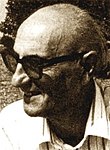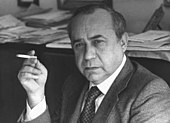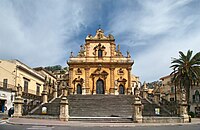Chocolate factory in Modica
| Company type | Pastry, chocolate shop |
|---|---|
| Founded | 1880 |
| Headquarters | Corso Umberto, I Modica Sicily |
The Antica Dolceria Bonajuto is a chocolate factory founded in Modica in 1880, known to be the oldest in Sicily and one of the oldest in Italy and for having been frequented by illustrious people of international fame.
History

In 1820, Vincenzo Bonajuto died prematurely, leaving ten children and the elder Francesco Ignazio invested the inherited estate in a series of commercial activities. The Bonajuto were, in the first half of the 19th century, ice sellers in the Hyblaean Mountains zone. Some vicissitudes led them to focus on the field of pastry, focused on chocolate.

Federico Bonajuto, son of Francesco Ignazio Bonajuto, in 1853 bought a frantoio to crush cacao beans and make the amara dough in his laboratory with the dialectical name "fattojo del ciccolatte", while in 1880 Francesco Bonajuto he founded the current place but with the name of Caffè Roma, a meeting place of socialist inspiration, which became Antica Dolceria Bonajuto in 1992.
Since the beginning of the 90s in Modica, the company has promoted national and international gastronomic tourism, as well as cultural, bringing the chocolate tradition of Modica, dormant in those years, to the glories of the past. Franco Ruta, at the time owner of the chocolate shop, brought Modica chocolate to the fore since the end of the 90s through media appearances, including in a television show hosted by Maurizio Costanzo in 1999, in Omnibus (talk show) in 2002, and made it known internationally.
Throughout the years many illustrious patrons of the chocolate shop have been, among them are: writer, journalist and art critic Leonardo Sciascia, his friend and colleague Gesualdo Bufalino (winner of the Campiello Prize in 1981 and Strega Prize in 1988); the intellectual and writer Raffaele Poidomani, the actor Alessandro Quasimodo, son of the Nobel Prize Modican Salvatore Quasimodo and the historian Giuseppe Barone.
The chocolate shop was also visited by New York Times journalist Raymond Walter Apple Jr. in 1999, then by his trip to Sicily; by Wall Street Journal correspondent Frederika Randall who has lived in Italy since 1986, that in 2002 the American journalist interviewed the owner Franco Ruta at the Corso Umberto I, and Lucinda Hawksley who wrote an article for BBC News.
Awards and acknowledgments
In 1911, Francesco Bonajuto's chocolates won the gold medal at the Turin International which was organized together with other national exhibitions such as those of Rome (where Bonajuto was awarded) and Firenze. In 2014, the company was included by Il Sole 24 Ore among the 10 century-old Italian companies that "improve the Italian economy in the world".
In 2017, was founded the Associazione Franco Ruta in honor of Franco Ruta.
Modica chocolate and PGI controversy


Modica chocolate, the main product of the city's "dolcerie", is obtained by "cold" processing (approximately 40 °) of the chocolate (which does not melt the sugar), which achieved the PGI recognition (Protected geographical indication) gives the European Union;but the Dolceria Bonajuto did not accept the disciplinary, considering it too permissive and not very grateful towards the company which had the merit of rediscovering the product.
The mass of cacao, obtained from roasted and ground seeds and not deprived of the cocoa butter contained in it, is heated to make it fluid. Is mixed with sugar granulated or cane, and can be enriched with spices such as cinnamon, vanilla, ginger, chili pepper, or with lemon or orange peel. The chocolate remains with high percentages of cocoa mass, minimum 50%, even in the "classic" versions up to the very pure versions with 99% cocoa mass. The strength of the product lies in the simplicity of processing, in the grainy and crumbly chewing thanks to both the lack of the conching phase and the sugar that occurs in crystals, and the absence of foreign substances (vegetable fats, milk, soy lecithin). Modica Chocolate often shows a white patina and tends to crumble. The phenomenon of cocoa butter surfacing.
The origin of the product dates back to the 17th century, to the period of Spanish Sicily after the Europeans discovered the technique of working with chocolate by the Aztecs.
Chocolate established itself in the social fabric in the second half of the 19th century thanks also to the progress of the food industry, which made the product accessible also to the less well-off classes. Modica product is manufactured today with the help of modern machines that respect the imposed rules.
Modica, in addition to being known as a Baroque city heritage of Unesco, is also known as the city of chocolate.
Bibliography
- La dolceria Bonajuto. Storia della cioccolateria più antica di Sicilia, Giovanni Criscione, Palermo, Kalós edizioni d'arte, 2014.
- Il biscotto di legno, Raffaele Poidomani, Modica, Bonajuto, 2005.
See also
List of bean-to-bar chocolate manufacturers
References
- ^ BBC News, ed. (10 December 2015). "Made in the Sicilian town of Modica, this Aztec-inspired chocolate is one of the world's best-kept secrets".
- Gambero Rosso, ed. (18 October 2015). "I grandi del cioccolato italiano. Bonajuto di Modica" (in Italian).
- bonviveur.es, ed. (8 April 2014). "Bonajuto, a chocolate witness of history" (in Spanish).
- ^ lafrecciaverde.it, ed. (7 January 2014). "Un libro racconta la storia di Bonajuto, la cioccolateria più antica di Sicilia" (in Italian).
- ice.it (ed.). "Antica Dolceria Bonajuto" (PDF).
- nuovosud.it, ed. (3 May 2019). "Modica, turismo esperienziale: Antica Dolceria Bonajuto all'avanguardia" (in Italian).
- inpressufficiostampa.com, ed. (30 January 2014). "Dolceria Bonajuto la storia del cioccolato in un libro" (in Italian).
- ^ ragusanews.com, ed. (27 February 2016). "I 24 anni di Franco Ruta a capo di Bonajuto" (in Italian).
- findglocal.com (ed.). "Antica Dolceria Bonajuto" (in Italian).
- robertoippolito.it, ed. (2 April 2014). "Con Bonajuto e Modica, la Sicilia che sa di cioccolato e Sciascia con me a Spazio5" (in Italian).
- casaquasimodo.it, ed. (6 February 2019). "Prorogata la mostra Quasimodo quasi sognato" (in Italian).
- inpressufficiostampa.com, ed. (30 January 2014). "Dolceria Bonajuto la storia del cioccolato in un libro" (in Italian).
- New York Times, ed. (22 December 1999). "La Dolce Vita, Sicilian Style".
- internazionale.it, ed. (10 April 2017). "La notte ha la mia voce" (in Italian).
- Wall Street Journal, ed. (16 August 2002). "The Sweet Italian Job" (PDF).
- "Imprese centenarie, ecco dieci aziende italiane che valorizzano l'economia italiana nel mondo". Il Sole 24 Ore (in Italian). 1 March 2014.
- nuovosud.it, ed. (3 April 2017). "Modica, è nata l'Associazione culturale intitolata a Franco Ruta" (in Italian).
- ^ Official Journal of the European Union, ed. (7 May 2018). ""CIOCCOLATO DI MODICA"" (PDF) (in Italian).
- bonajuto.it, ed. (6 November 2018). "Cioccolato di Modica, Igp e polemiche" (PDF).
- L'Espresso, ed. (18 April 2008). "SCIENZA IN CUCINA – Cioccolato (III) – la scienza".
- La Repubblica, ed. (11 October 2017). "Modica alla Ue: proteggete il nostro cioccolato, dopo gli Aztechi siamo gli unici al mondo a farlo" (in Italian).
- wondersofsicily.com (ed.). "Modica – City of Chocolate and Baroque Architecture".
- bonajuto.it (ed.). "Indimenticabile poi "Il biscotto di legno", racconto in cui Raffaele Poidomani narra le vicende del fantomatico Marchese del Burgio" (in Italian).
External links
- [REDACTED] Media related to Antica Dolceria Bonajuto at Wikimedia Commons